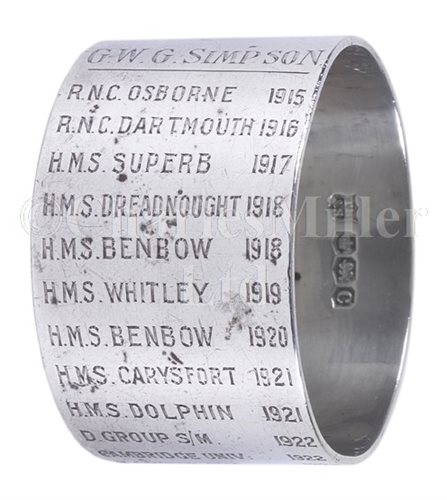29th Oct, 2014 12:00
Maritime and Scientific Models, Instruments & Art (Wizard)
70
[M] AN HISTORICALLY INTERESTING SILVER NAPKIN RING...
engraved G.W.G SIMPSON and then listing every vessel served on between 1915-28, Sheffield hallmarks for 1920-21 -- 2in. (5cm.) diameter
George Walter Gillow Simpson (1901-1972) became a submariner in 1921. His greatest service to the navy was compressed into two strenuous years from January 1941 to January 1943 while he commanded the flotilla of submarines (to become famous as the Fighting Tenth) based on the beleaguered island of Malta in the centre of the Mediterranean and which had long been crucial to the Royal Navy's strategy; Now wholly reliant on seaborne supplies for its military and civilian needs, it was susceptible to siege by air forces and very difficult to defend. Grand Harbour could not safely be used by surface ships, but submarines were able to lie in Marsamxett where the solid old Lazaretto isolation hospital offered protection for personnel and some shelter for submarines alongside. Admiral Cunningham, C-in-C, Mediterranean, assigned Simpson the prime task of preventing supplies and reinforcements from Italy reaching axis armies in North Africa. The enemy supply lines could be reached in a day or so by the slow, small U-class submarines and proximity permitted three or four regulars to be on patrol at any one time; but wartime dangers were exacerbated by confined and revealingly clear waters, a shortage of torpedoes, and increasingly expert enemy counter-measures. Submarine casualties were heavy throughout the Mediterranean. Twenty-three boats were sunk during his time at Malta: twelve had sailed from his flotilla and two were bombed in harbour. But Simpson, with a cheerfully unpretentious brand of leadership and an absurdly small staff, consistently ran the show at peak efficiency despite daunting discouragements. More to the point, his tenth flotilla did all that was required of it, and more.
Sold for £198
Estimated at £150 - £200
(inc. buyer's premium of 24%)
Condition Report
a little warped with age/use, marks commensurate with age.
We are pleased to provide you with a general report of the condition of this property. Since we are not professional conservators or restorers, we urge you to consult with a restorer or conservator of your choice who will be better able to provide a detailed, professional report. Prospective buyers should inspect each lot to satisfy themselves as to condition and must understand that any statement made by Charles Miller Ltd is merely a subjective, qualified opinion. Prospective buyers should also refer to any Important Notices regarding this sale, which are printed in the Sale Catalogue. NOTWITHSTANDING THIS REPORT OR ANY DISCUSSIONS CONCERNING A LOT, ALL LOTS ARE OFFERED AND SOLD “AS IS” IN ACCORDANCE WITH THE CONDITIONS OF BUSINESS PRINTED IN THE SALE CATALOGUE.
engraved G.W.G SIMPSON and then listing every vessel served on between 1915-28, Sheffield hallmarks for 1920-21 -- 2in. (5cm.) diameter
George Walter Gillow Simpson (1901-1972) became a submariner in 1921. His greatest service to the navy was compressed into two strenuous years from January 1941 to January 1943 while he commanded the flotilla of submarines (to become famous as the Fighting Tenth) based on the beleaguered island of Malta in the centre of the Mediterranean and which had long been crucial to the Royal Navy's strategy; Now wholly reliant on seaborne supplies for its military and civilian needs, it was susceptible to siege by air forces and very difficult to defend. Grand Harbour could not safely be used by surface ships, but submarines were able to lie in Marsamxett where the solid old Lazaretto isolation hospital offered protection for personnel and some shelter for submarines alongside. Admiral Cunningham, C-in-C, Mediterranean, assigned Simpson the prime task of preventing supplies and reinforcements from Italy reaching axis armies in North Africa. The enemy supply lines could be reached in a day or so by the slow, small U-class submarines and proximity permitted three or four regulars to be on patrol at any one time; but wartime dangers were exacerbated by confined and revealingly clear waters, a shortage of torpedoes, and increasingly expert enemy counter-measures. Submarine casualties were heavy throughout the Mediterranean. Twenty-three boats were sunk during his time at Malta: twelve had sailed from his flotilla and two were bombed in harbour. But Simpson, with a cheerfully unpretentious brand of leadership and an absurdly small staff, consistently ran the show at peak efficiency despite daunting discouragements. More to the point, his tenth flotilla did all that was required of it, and more.
Auction: Maritime and Scientific Models, Instruments & Art (Wizard), 29th Oct, 2014
